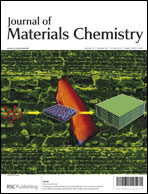A series of novel bipolar blue phosphorescent host materials mBICP, mBINCP and mBIPhCP have been designed and synthesized, which comprehensively outperform the widely used phosphorescent host, 1,3-di(9H-carbazol-9-yl)benzene (mCP). The thermal, photophysical and electrochemical properties of these host materials were finely tuned through linking different carbazole moieties to the benzimidazole. mBICP (Tg = 84 °C) and mBIPhCP (Tg = 103 °C) exhibit high morphological stabilities in comparison with mCP. Theoretical calculations show that the HOMO/LUMO orbitals of these materials are mainly dispersed on the electron donating and electron accepting groups, respectively. A blue PhOLED device fabricated using mBICP as the host exhibits a maximum external quantum efficiency (ηEQE,max) of 18.7% and a maximum power efficiency (ηP,max) of 33.6 lm W−1. Interestingly, the external quantum efficiencies (ηEQE) are still as high as 17.1% at a high luminance of 1000 cd m−2. Furthermore, the two-color, all-phosphor and single-emitting-layer white device hosted by mBICP achieved a maximum external quantum efficiency (ηEQE,max) of 20.5% corresponding to a maximum power efficiency (ηP,max) of 53.3 lm W−1.

You have access to this article
 Please wait while we load your content...
Something went wrong. Try again?
Please wait while we load your content...
Something went wrong. Try again?


 Please wait while we load your content...
Please wait while we load your content...